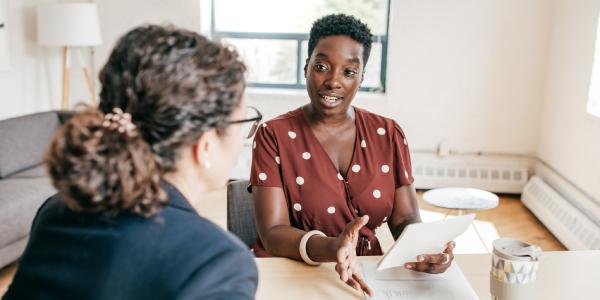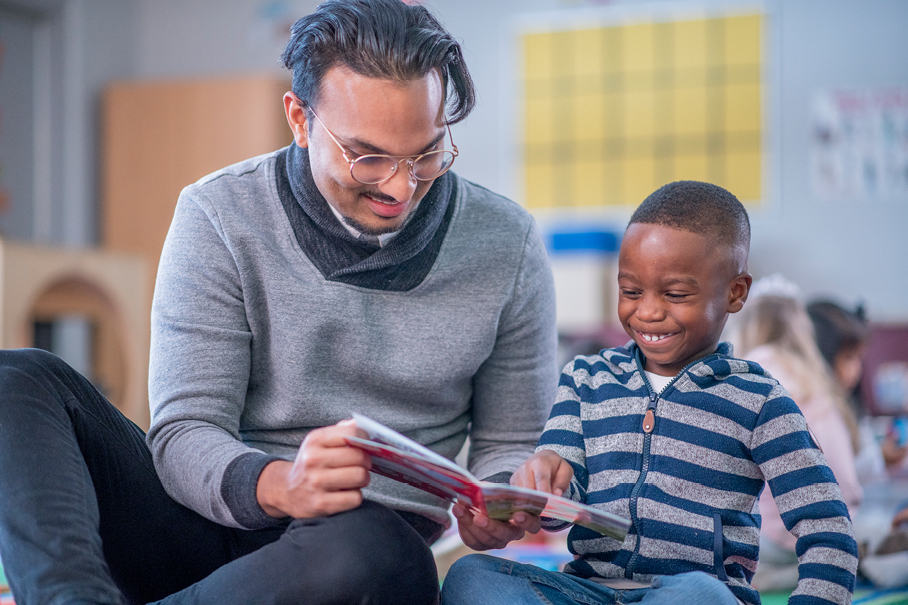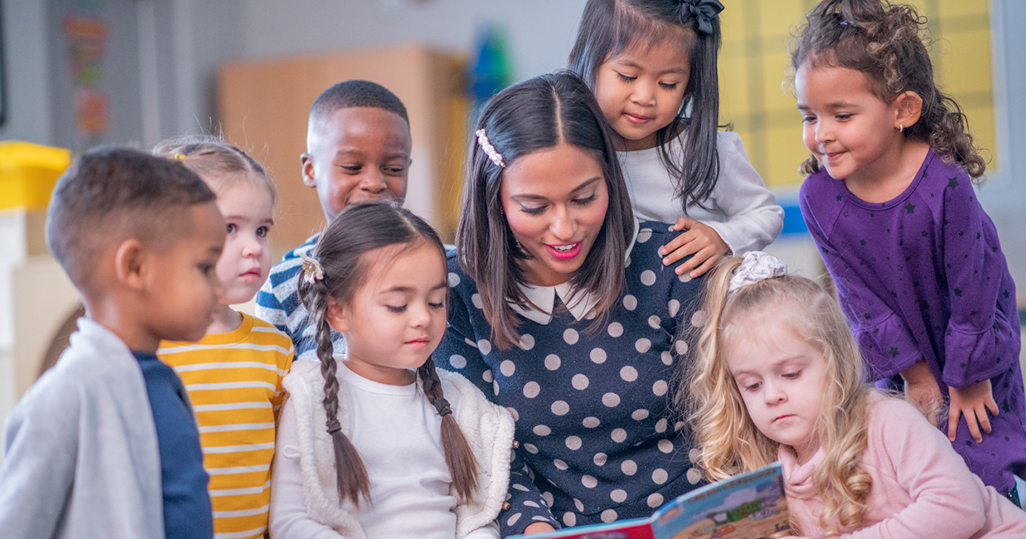Beginning (or Continuing) the Journey to a More Equitable Classroom

You are here
Teacher Carly is preparing to read aloud her 4-year-old students’ favorite book, The Pigeon Finds a Hot Dog, by Mo Willems. All, except for Jamal, are quietly sitting on the rug and waiting for her to begin. As she scans the group, her eyes stop on Jamal. She takes a breath and thinks, “Why is Jamal always interrupting, fidgeting, and bothering everyone while I read?” Just then, Jamal starts to make loud chewing noises and offers imaginary hot dogs to the children sitting next to him. “Why is he always so difficult?” she ponders.
As the United States becomes more aware of the many ways that bias permeates our everyday lives, things are changing. Companies (big and small), sports organizations, musicians, and other popular figures are reexamining–or examining for the first time–the words and images that they convey. They are recognizing and, in some cases, making changes to products and advertisements to counter stereotypical, unfair, or hurtful representations of race, gender, and other aspects of identity. For example, the labels and names of Aunt Jemima syrup and Uncle Ben’s rice are undergoing changes, acknowledging that they are based on racial stereotypes. And to encourage gender identity inclusion, the Cartoon Network celebrated LGBTQIA+ Pride month and has claimed to “Stand Proud All Year Long.”
As educators, we too must take a look inward and evaluate our own thoughts, ideas, and practices, as we acknowledge our past mistakes and strive for equity. Doing this kind of thinking, reflecting, and improvement can be overwhelming, uncomfortable, or upsetting. It is also a necessity. Here are just a few reasons why:
- Some preschool teachers unconsciously feel that Black boys are more likely to misbehave and have lower expectations from Black boys than other children. They are much more likely to be suspended and even expelled from preschool than their White peers.
- There are inaccuracies and gaps in how cultures, groups of people, and events are written about and represented in books, in the media, and in education. For example, Columbus Day and Thanksgiving are not celebrations for many people.
- Children from LGBTQIA+ families, or children who identify as gender fluid or gender nonconforming, may be bullied and marginalized.
These findings from research by no means represent the wide range of biased thinking, language, and behaviors that can occur in educational settings. Indeed, what research shows is that we all have implicit or unconscious associations and feelings that affect the way we make decisions and act. Sometimes we have these feelings even though they are contrary to our conscious or declared beliefs. They are the stories we unconsciously make up in our minds about people or groups without knowing or understanding the facts. Becoming aware of them can help us grow and change.
NAEYC’s position statement on Advancing Equity in Early Childhood Education and a key NAEYC book, Anti-Bias Education for Young Children and Ourselves, by Louise Derman-Sparks and Julie Olsen Edwards with Catherine M. Goins (2020), ask us to carefully consider how biases contribute to our work with children. Biases can influence the verbal and nonverbal interactions and messages we send children and the way we look at particular classroom situations and children’s behavior.
Knowing that we all have implicit biases and, simultaneously, have the capacity to change our thinking and improve our practices, we’ve outlined four steps that early childhood educators can take to understand our own biases and to take action to advance equity:
-
Reflect on your current beliefs, attitudes, and practices.
-
Set goals that connect to or come from your self-reflection.
-
Identify steps to take toward achieving your goals, finding resources, and taking action.
-
Assess your progress and look ahead.
Early childhood educators are known for being lifelong learners and committed to continually growing as professionals. These steps can be a part of your overall professional development, and we suggest finding supportive colleagues and mentors to join you on this journey.
Reflect on current beliefs, attitudes, and practices
 To begin, ask yourself a series of questions about your beliefs, attitudes, and experiences related to children, families, and the broader world around you. For example:
To begin, ask yourself a series of questions about your beliefs, attitudes, and experiences related to children, families, and the broader world around you. For example:
- Do you notice when a Black boy starts wiggling around on the rug more than when a White boy does this?
- Do you engage in one-on-one conversations with certain children much more often than others?
- Do you feel uncomfortable during a conference with two moms?
- Do you think that it is silly when you hear that some teachers don’t want to have a Thanksgiving feast or teach the names of Columbus’s three ships?
Set goals
Based on your reflections, create one to two goals. Give yourself a timeline with at least one short-term and one long-term goal. For example:
- Finding developmentally appropriate ways to acknowledge and support positive behaviors of the students who display challenging behaviors
- Getting to know each child and family in your setting
- Understanding the history and issues behind the LGBTQIA+ movement
- Learning more about why Columbus Day and Thanksgiving are days of mourning for Native American people and how to accurately teach children about the history about these days
Identify steps to take, find resources, and take action
After creating your goals, select and engage in activities that will help you make progress toward reaching them. These actions may include:
- reading books, articles, and blogs
- watching videos online and listening to podcasts
- attending workshops and conference sessions (in person or virtually)
- trying out new strategies, activities, and materials in your setting
- discussing your questions, learning, and progress with a trusted colleague and asking them to observe you
- connecting with families to learn more about their experiences, hopes, and concerns
Assess your progress and look ahead
After giving yourself sufficient time to take action, it is important to gauge your progress, including:
- successes you’ve experienced
- challenges or setbacks you’ve encountered
- how children’s learning and your relationships with them have been impacted
- how partnerships with families have improved
- questions that remain
- evidence of your journey (writing, photos, video recordings)
Let’s take a peek at Teacher Carly’s journey as she used these four steps to understand more about her implicit bias toward Jamal and to grow as an educator and person.
Carly begins by reflecting back on her thoughts about Jamal. Is he really always engaged in negative behaviors, or does she notice his behaviors more than others’? Does she recognize and build on his strengths? Carly thinks about the fact that she only has one or two Black children in her class each year. She wonders whether she, unconsciously, has different opinions and expectations about children of color, and she wonders if she takes the time to connect with families of color as often as she does White families?
So she sets goals for herself. Her long-term goal is to identify and understand her own biases. One short-term goal is to observe Jamal’s behaviors during read aloud and morning meeting for two weeks. She will then analyze her notes for any patterns in her words and actions and in Jamal’s behaviors. Another short-term goal is to reach out to Jamal’s family to learn about their expectations for him, his strengths, and any questions they may have.
After setting these goals, Carly identifies steps to take to support her efforts. She creates a form to record her and Jamal’s behaviors and asks her assistant teacher to use it too so they can compare notes. Carly also begins using a journal for each child to send home a positive note about the child’s day. Families can add to the journal about their child too. Finally, Carly asks the director of the program if they can devote time during each staff meeting to discuss resources about understanding and countering bias (see “Beginning [or Continuing] Your Journey toward Equity” and “Further Resources to Support Your Journey” below for suggested resources), with each teacher having a chance to lead a discussion about one resource.
Six months later, Carly looks back to assess her work with Jamal and her own growth. She notes successes: for example, she placed picture books and props into the dramatic play area and observed Jamal frequently acting out stories and creating puppet shows with the other children. He also likes to bring some of these materials home to perform for his family.
Her program’s staff has also begun to engage in many meaningful, sometimes difficult conversations during their monthly meetings. Spurred by these powerful discussions, they plan to hold a book club next year focused on Anti-Bias Education for Young Children and Ourselves, and they will set goals, take action, and assess their progress in implementing anti-bias strategies and examining their own thinking and behaviors.
Having committed to this journey, Carly feels proud that she’s been able to confront her biases and reexamine how she interacts with students and families, to improve her classroom practices, and to increase her leadership role in her setting.
Conclusion
It can be scary to have conversations about race, gender, and other topics that you aren’t comfortable talking about. But, with dedicated planning, action, and reflection, your quest to understand and address your own biases will make a difference in young children’s and families’ lives and yours too.

Beginning (or Continuing) Your Journey toward Equity
Here are some resources to get you started on your journey.
Read Online
- Dena Simmons’s “How to Be an Antiracist Educator” in ASCD Education Update, October 2019.
- Dana Williams’s Beyond the Golden Rule: A Parent’s Guide to Preventing and Responding to Prejudice.
- NAEYC’s Advancing Equity Initiative, Advocacy Resources, and recent content on equity and diversity from NAEYC’s publications.
- Teaching Tolerance’s resources (use the search word “preschool”) and online magazine.
Listen to These Podcasts
- NPR’s Parenting: Difficult Conversations: “Talking Race with Young Children” (20 minutes)
- Harvard EdCast: “Unconscious Bias in Schools” (28 minutes)
- The Early Link Podcast: “Soobin Oh Discusses Anti-Bias Education in Early Childhood” (34 minutes)
- BBC Radio 4’s Analysis: “Implicit Bias” (27 minutes)
Watch online
- Chimamanda Ngozi Adichie’s “The Danger of a Single Story” (18 minutes)
- Russell McClain’s “Implicit Bias, Stereotype Threat, and Higher Education” for TEDxUMBaltimore (11 minutes)
- Alice Goffman’s “How We’re Priming Some Kids for College and Others for Prisons” (15 minutes)
- “Tyler Perry Speaks from the Heart about Racial Injustice and the World He Wants for His Son” for People magazine (9 minutes)
- “Native American Girls Describe the Real History Behind Thanksgiving” for Teen Vogue (2 minutes)
- “Why These Native Americans Observe A National Day of Mourning Each Thanksgiving” for HuffPost (5 minutes)
- “Columbus Day vs. Indigenous Peoples Day” for KARE 11 News (4 minutes)
Further Resources to Support Your Journey
Here is a recommended reading list to support your anti-biased work with young children.
Burt, T., A. Gelnaw, & L.K. Lesser. 2010. “Do No Harm: Creating Welcoming and Inclusive Environments for Lesbian, Gay, Bisexual, and Transgender (LGBTQ) Families in Early Childhood Settings.” Young Children 65 (1): 97–101.
Bisson, J. 1997. Celebrate: An Anti-Bias Guide to Enjoying Holidays in Early Childhood Programs. St. Paul, Minnesota: Redleaf Press.
Bigelow, B., & B. Peterson (eds). 1998. Rethinking Columbus: The Next 500 Years, 2nd edition. Milwaukee: Rethinking Schools.
Derman-Sparks, L., J.O. Edwards, & C.M. Goins. 2020. Anti-Bias Education for Young Children and Ourselves, 2nd edition. Washington, DC: NAEYC.
Friedman, S., & A. Mwenelupembe, 2020. Each and Every Child: Teaching Preschool with an Equity Lens. Washington, DC: NAEYC.
Jones, G., & S. Moomaw. 2002. Lessons from Turtle Island: Native Curriculum in Early Childhood Classrooms. St. Paul: Redleaf Press.
Gallavan, N. 2010. Multicultural Education, 15th edition. New York: McGraw-Hill.
Gilliam, W.S., A.N. Maupin, M. Accavitti, & F. Shic. 2016. “Do Early Educators’ Implicit Biases Regarding Sex and Race Relate to Behavior Expectations and Recommendations of Preschool Expulsions and Suspensions?” Research study. New Haven: Yale University Child Study Center. https://medicine.yale.edu/childstudy/zigler/publications/Preschool%20Implicit%20Bias%20Policy%20Brief_final_9_26_276766_5379_v1.pdf
Gonzalez-Mena, J. 2008. Diversity in Early Care and Education: Honoring Differences, 5th edition. Washington, DC: NAEYC.
Hyland, N. 2010. “Social Justice in Early Childhood Classrooms: What Research Tells Us.” Young Children 65 (1): 82–90.
Jaboneta, N., & D. Curtis. 2019. “‘What If I Say the Wrong Thing?’ Talking about Identity with Young Children.” Teaching Young Children 12 (4): 16–19.
Mwenelupembe, A. 2020. “6x: What to Do To Prevent Preschool Expulsion.” Teaching Young Children 13 (3): 10–11.
NAEYC (National Association for the Education of Young Children). 2019. “Now Read This!: Books that Support Diversity, Conversations, and Play.” Teaching Young Children 12 (2): 20–21.
Wolpert, E. 2005. Start Seeing Diversity: The Basic Guide to an Anti-Bias Classroom. St. Paul: Redleaf Press.
Special Thanks to NAEYC member Emmy Brockman who shared her List of Anti-racism Resources for Parents/Educators of Young Children on NAEYC’s online forum HELLO.
Photographs: © Getty Images
Copyright © 2021 National Association for the Education of Young Children. See permissions and reprints online at NAEYC.org/resources/permissions.
Janis Strasser is professor emerita from William Paterson University. She has been a kindergarten/preschool teacher, Head Start education coordinator, and consultant, and she has written many articles for Young Children and Teaching Young Children. For the past several years, Dr. Strasser has been working with preschool teachers on the island of Anguilla during the winter months.
Llariley Coplin is a student at Boston University majoring in Public Relations and an advocate for social justice.